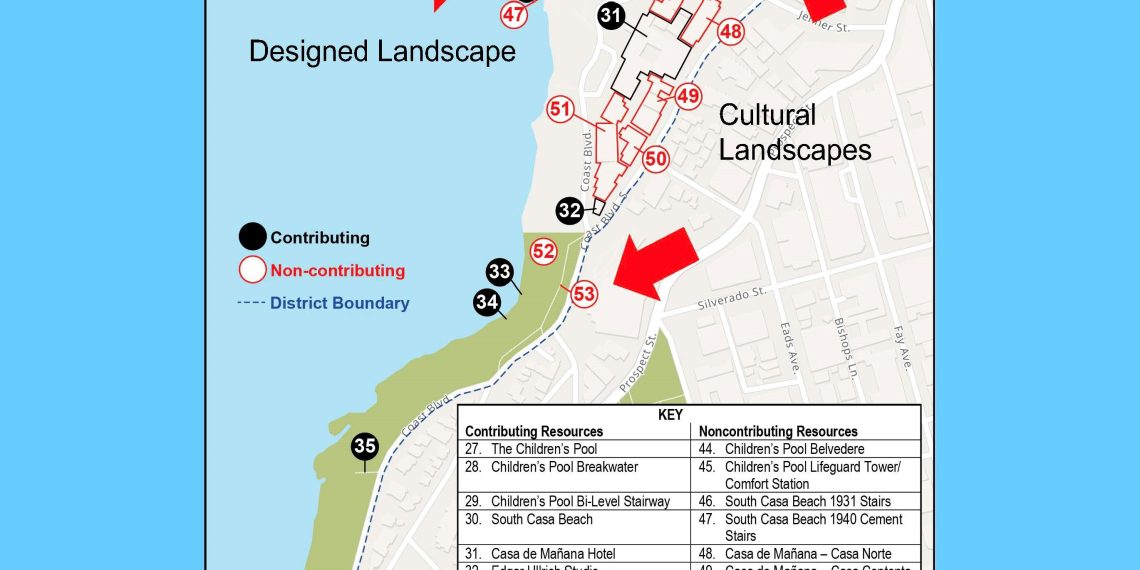
Thanks to the efforts of La Jolla Historical Society and others “the Jewel” now has a new crown setting: La Jolla Park Coastal Historic District.
As of May 9, the freshly minted historic district was officially created, having been listed on both the National Register of Historic Places and the California Register of Historic Resources. Some individual district features are also listed on the City of San Diego Register of Historic Resources.
Authorized by the National Historic Preservation Act of 1966, the National Park Service’s National Register of Historic Places is part of a national program to coordinate and support public and private efforts to identify, evaluate, and protect America’s historic and archeological resources.
A dramatic stretch of coastline that is part of the unceded ancient homeland and traditional territory of the Kumeyaay Nation, the new La Jolla Park Coastal Historic District is firmly anchored around Ellen Browning Scripps Park, which was the focal point for La Jolla’s planning and development between 1887 and 1940. The historic district, which includes La Jolla Cove and Children’s Pool, is one of the most popular visitor attractions in Southern California.
Architectural historian and former City senior planner Diane Kane talked about the new historic district’s significance. “This effort has been in the works for at least the last five years,” said Kane, who worked closely with La Jolla architect Ione Stiegler on the recent renovation of Wisteria Cottage, La Jolla Historical Society’s home. Kane noted she, LJHS historian Carol Olten, and LJHS executive director Lauren Lockhart, along with USD professor Dr. Molly McClain “put all our heads together creating this large district and dumping everything into it that went together.”
Kane said the involved process to get the new historic district designated and listed at both the national and state levels started in November of 2023. Speaking of what the new district accomplishes, she noted, among other things, that “it clarifies the boundaries of what is historically significant” in coastal La Jolla. She added there are two classifications for historical significance: one for buildings and another for landscapes. “This is a district that has a combination of those two,” Kane concluded adding, that though historical designation is celebratory, it also serves to “show that we’ve got something special here and that we need to protect it.”
The La Jolla Coastal Historic District is the first nationally recognized district in La Jolla and one of only 26 in San Diego County. A listing on the National Register of Historic Places recognizes only those places that are of exceptional value to the nation as a whole and achieves the following goals:
● It helps to preserve and protect a unique landscape that is part of the historic fabric of La Jolla.
● It describes the historical context for the town’s planning, one linked to the 19th-century American Park Movement introducing country landscapes into American cities.
● It celebrates the area’s unique marine resources underwater canyons, kelp forests, and rocky shorelines, including coastal birds and wildlife.
● It identifies sites and structures of significance to La Jolla’s planning and development: Coast Walk Trail, Devil’s Slide Footbridge, Cave Store and Tunnel, historic cottages, Casa de Mañana Hotel, and the Adult Recreation Center, Ellen Browning Scripps Park, and the Children’s Pool.
The nomination of La Jolla Park Coastal Historic District to the National Register of Historic Places was authored by Seonaid McArthur, art historian and preservationist, and Dr. Molly McClain, professor of history at the University of San Diego, on behalf of the La Jolla Historical Society. Information about the Children’s Pool and technical edits were provided by Kane, an architectural historian.
In a nod to La Jolla’s original inhabitants in creating the new historic district, LJHS said: “We gratefully acknowledge the heritage of this land of the sovereign bands of Kumeyaay, their ancestors of the past, their people of the present, and their descendants of the future. We will honor and uplift the history, language, and culture of the Kumeyaay, and act as a platform to elevate native voices.”






Discussion about this post